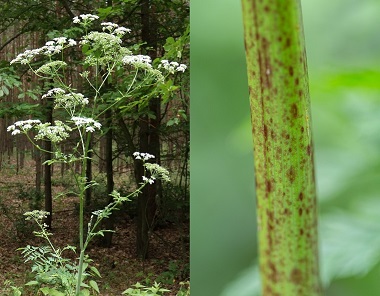What is poison hemlock?
The hemlock plant, scientifically known as Conium maculatum, is a poisonous herb from the Apiaceae plant family. All parts of the plant, including the seeds, roots, stems, leaves and fruit are poisonous.
Hemlock typically emerges in spring and looks similar to plants like wild carrot, wild parsnip or wild parsley. This can lead people to accidentally ingest it, with potentially fatal consequences. While hemlock prefers moist environments, such as wetlands and riverbanks, it can also survive in dry conditions and tolerates grasslands, agricultural lands and managed forests.
What does poison hemlock look like?

Identifying poison hemlock can be tricky because it looks like other plants. The plant has smooth, green, hollow stems that may have red or purple spots. Its leaves are lacy, divided and triangle shaped. Hemlock can grow between 2 to 10 feet tall. It has small white flowers that form loose clusters, each with five petals. These flower heads bloom in June and July and develop into green, ridged fruits with seeds. While it resembles other similar species such as wild carrot, wild parsnip and wild parsley, poison hemlock is smoother, greener and taller.
For more information and images to help identify poison hemlock, visit https://kingcounty.gov/en/dept/dnrp/nature-recreation/environment-ecology-conservation/noxious-weeds/identification-control/poison-hemlock.
How harmful is poison hemlock?
Poison hemlock contains harmful alkaloids which are poisonous and even a tiny amount (less than one tenth of a gram, which is about six to eight hemlock leaves), can be deadly for adults. The entire plant is toxic, but the seeds have high concentrations of these harmful chemicals. Accidentally eating this plant can affect the central nervous system, cause breathing problems, muscle breakdown, kidney failure and even death. It’s poisonous when ingested but typically does not cause harm upon skin contact. However, poison hemlock should still be handled with caution because it can lead to irritation in individuals with sensitive skin.
What are the symptoms of exposure to poison hemlock?
Poison hemlock poisoning symptoms can appear quickly after ingestion, from 30 minutes to 3 hours depending on the amount ingested. Notable symptoms include unsteadiness and weakness, abnormal sweating, vomiting, drooling, confusion, muscle twitches or tremors, and seizures.
What treatment is needed if exposed?
If you think someone has accidentally ingested poison hemlock, call the Poison Control Centre at 604-682-5050 or 1-800-567-8911, or go to the nearest emergency room immediately. There is no specific antidote for hemlock poisoning, but medications can be given to reduce symptoms and prevent serious harm. Treatment will depend on how much hemlock is consumed, how toxic the plant is and the overall health of the person.
Possible treatments may include:
- Mechanical ventilation for breathing difficulties
- Anti-seizure medication
- Hemodialysis for kidney failure
- Intravenous (IV) fluids to prevent dehydration and provide nutrition
Does poison hemlock affect pets and livestock?
Eating poison hemlock can make many animals sick, including cows, pigs, sheep, goats, donkeys, rabbits and horses. Farmers must ensure that animal feed does not contain any poison hemlock. If animals eat this plant, they may show symptoms such as tremors, loss of balance and excessive drooling. The plant's toxins can slow down nerve function, affecting all muscles, including those used for breathing. This can lead to breathing problems or even suffocation. Seek veterinary care immediately for animals that may have been exposed to poison hemlock.
How do I get rid of poison hemlock?
It’s best to hire a professional to manage poison hemlock infestations. If you are removing it yourself:
- Do not touch the plant with bare skin. Wear protective gear such as rubber gloves, goggles or a face shield, a protective suit, boots and a respirator (such as N95 or KN95)
- Carefully dig down to remove the plant, including its roots. Do not cut, mow or burn the plant to avoid spreading seeds or releasing toxic fumes
- Do not place poison hemlock in your backyard composter. Bag the plants carefully and place them in the regular trash
Who should I contact to report poison hemlock?
Because poison hemlock is an invasive species, you can submit a report to the Ministry of Forests by using the Report Invasives mobile app. For more information, visit www2.gov.bc.ca/gov/content/environment/plants-animals-ecosystems/invasive-species/reporting-invasive-species.
For more information
- Washington State Noxious Weed Control Board: Poison Hemlock: Options For Control www.nwcb.wa.gov/images/weeds/poisonhemlock_Lincoln.pdf (PDF, 727 KB)
- Colorado Department of Agriculture: Poison hemlock https://ag.colorado.gov/conservation/noxious-weeds/noxious-weed-species-id/poison-hemlock
- Metro Vancouver: Tackling poison hemlock (Conium maculatum) https://metrovancouver.org/services/regional-planning/Documents/poison-hemlock-fact-sheet.pdf (PDF, 2.7 MB)
- Government of British Columbia: Poison hemlock alert www2.gov.bc.ca/assets/gov/environment/plants-animals-and-ecosystems/invasive-species/alerts/poison_hemlock_alert.pdf (PDF, 538 KB)
- Health Canada: Weed Seed: Conium maculatum (Poison hemlock) https://inspection.canada.ca/en/plant-health/seeds/seed-testing-and-grading/seeds-identification/conium-maculatum
